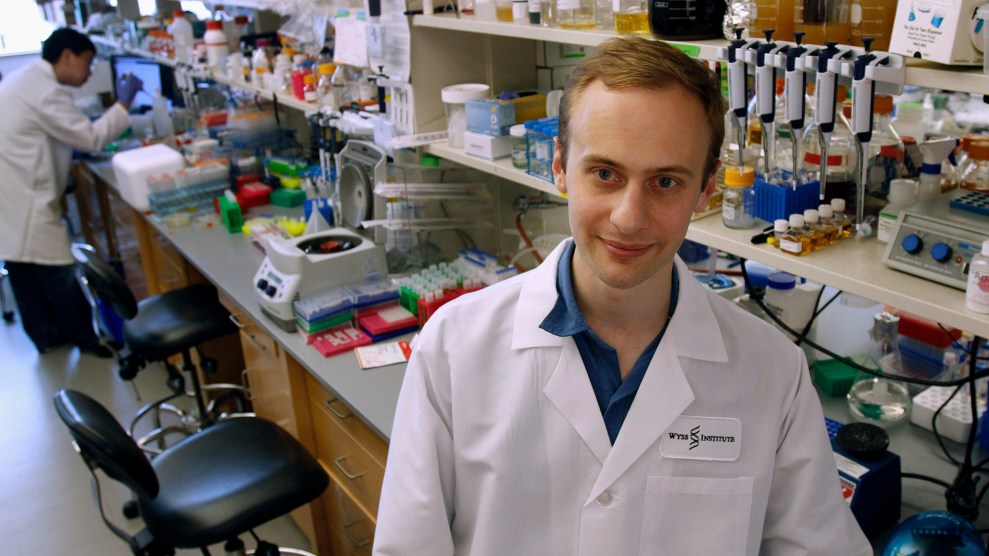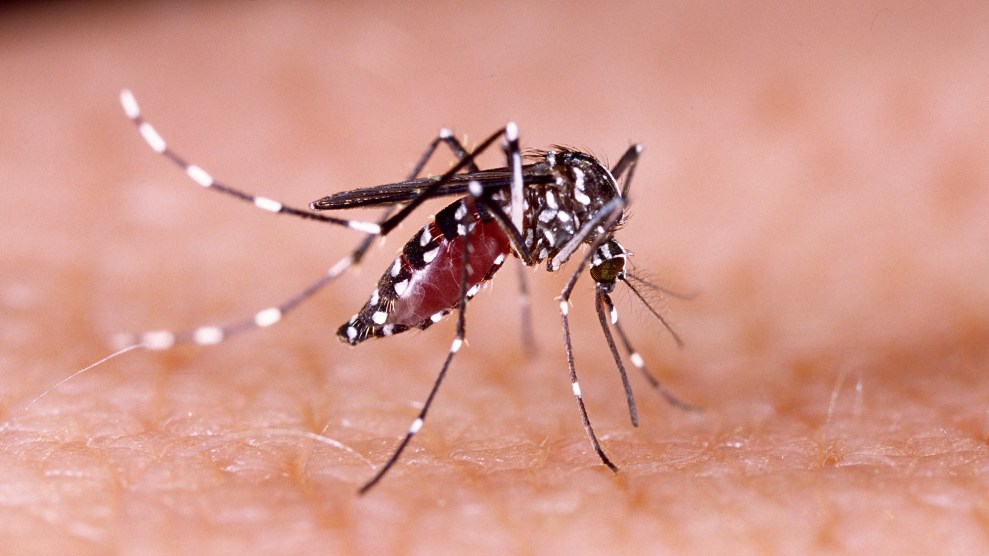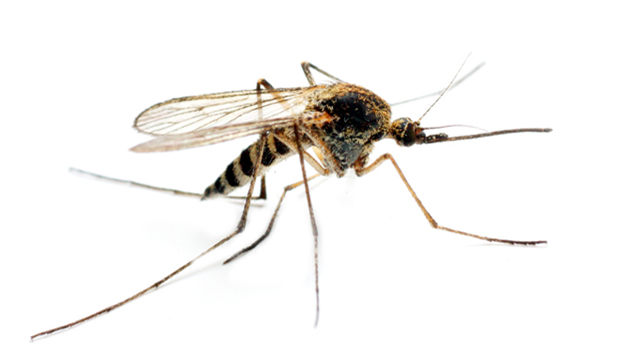
A Tanzanian mother and child took part in a 2007 malaria vaccine trial.Steve Ringman/TNS via ZUMA Press
This story was originally published by Undark and is reproduced here as part of the Climate Desk collaboration.
When the World Health Organization approved a malaria vaccine for the first time in October 2021, it was widely hailed as a milestone. “This is a historic moment,” said WHO director-general Tedros Adhanom Ghebreyesus in a statement that month.
The vaccine—dubbed RTS,S—promises a 30 percent reduction in severe malaria in fully vaccinated children. In 2020, a research team estimated that each year, the vaccine could prevent between 3 and 10 million malaria cases, and save the lives of 14,000 to 51,000 small children, depending on how it’s implemented.
What those plaudits often failed to note, though, was that the core ingredient of the path-breaking vaccine was actually almost 35 years old—and that researchers have known since the late 1990s that the formula was probably somewhat effective at protecting against malaria.
At a time when Covid-19 vaccines were developed and authorized in less than one year, the delay for malaria raises a question: Why did a vaccine for a leading global killer take so long to arrive? According to researchers involved in the development of RTS,S, the answer involves the challenges of developing a vaccine against a vexing parasite—and the chronic lack of urgency and funding behind malaria research, which stymied the logistics of research trials at every step.
The people who are affected by malaria, “they’re not Europeans, they’re not Australians, they are poor African children,” said Ashley Birkett, director of the malaria vaccine initiative at PATH, a non-profit global health organization. “Unfortunately, I think we have to accept that that is part of the reason for the lack of urgency in the community.”
Researchers had been searching for a malaria vaccine since the late 1960s. In 1980, they identified a protein that is abundant on the parasite’s surface, called circumsporozoite protein, and realized that a vaccine directed against this protein might grant immunity. After US government researchers sequenced the gene for the protein in 1984, the military asked them to develop a malaria vaccine to protect troops overseas. Government officials then enlisted Smith, Kline & French, a precursor company to the pharmaceutical giant GlaxoSmithKline, to help.
The work, experts recalled, was extremely challenging. The malaria parasite has a notoriously complex life cycle with at least three distinct stages once it’s inside humans, and it is “actually changing clothes during the evolution, during the cycle,” said Lode Schuerman, the scientific affairs director for GSK’s global health vaccines program. Any vaccine developed against a particular stage would have to stop the infection then, and would not work if the parasite has advanced to the next stage. Moreover, basic tools that researchers use today to speed up vaccine development did not yet exist.
More than a dozen attempted vaccines based on the circumsporozoite protein failed. The exception was RTS,S. In the late 1980s and early 1990s, the team figured out various technical details, and a 1998 trial in Gambia, involving 250 men, found that the vaccine prevented 34 percent of infections.
“That was really the start of RTS,S,” said Brian Greenwood, an infectious disease expert at the London School of Hygiene and Tropical Medicine who was involved in the Gambia trial.
Still, attention to the vaccine, Greenwood recalled, was driven more by intellectual interest than a sense of medical urgency—at least for the broader public, beyond American troops. “I don’t think there was any sort of push. It was done by people who were more academics and interested in the immunology,” he said. “It wasn’t seen as a public health issue.”
And, people involved in the vaccine’s development told Undark, the promising shot was about to run into a whole new set of problems: the myriad tribulations that come with testing a vaccine that doesn’t have a commercial market.
In 1999, Ripley Ballou, a vaccinologist who then worked at the Walter Reed Army Institute of Research, flew to Europe to meet with GSK executives. “I was still in the Army at the time,” he recalled, “and we were there in our uniforms in Belgium.” In a conference room with long tables, Ballou and his colleagues from GSK sat down and presented their findings from the Gambia trial. “We had this glimmer of hope that came from this study that says, ‘you know, what, something is happening here, and we think we really need to take it to the next step,’” he said. And that next step would be to trial the vaccine in the group who would most benefit: children.
GSK agreed to go forward—provided Ballou and his colleagues could come up with some additional funding from a partner organization. There was a high risk the project would fail; even if it did succeed, GSK could expect little financial reward. And the US military was no longer interested in RTS,S, unconvinced the efficacy would do enough to protect the troops.
Instead, the partner organization that funded the work turned out to be the Malaria Vaccine Initiative at PATH established just a year earlier through a grant from the Bill and Melinda Gates Foundation.
As the vaccine makers began launching trials in African countries, they soon realized that the task of testing the vaccine was going to be far from easy. There were a lot of logistical issues, said Ballou. “We had to go and there would be a building with nothing in it, just a concrete shell, and we had to turn it into a laboratory,” he recalled. “That took time, that took money.”
These trials were also aimed at young infants and small children, and so the Phase I and II trials, which look at the shot’s safety and efficacy, had to be first conducted in adults, then in older children, and finally in small children—optimizing the dosage against side effects for each age group before moving on. “All that process took about 10 years,” said Greenwood.
The promising results from Phase II trials—in which infants saw a 66 percent reduction in the rate of infection compared to the control group in the months after the third dose—led to a large-scale Phase III trial, which did not begin until 2009. There was a steep learning curve for designing the trial, Ballou said, “Nobody had ever done a malaria vaccine trial at this scale.”
The Phase III trials ran from 2009 to 2014 in seven sub-Saharan African countries. They enrolled over 15,000 children. And the results were promising—so much so that GSK began preparing a manufacturing facility for the shot, according to Schuerman.
But in October 2015, a WHO review of the Phase III trial data found that the rate of meningitis was higher in the vaccinated group than the control and death was higher among girls who had received a vaccine, although whether it was linked to the shot wasn’t clear. To address these issues and to test the vaccine in a broader real-life setting, the WHO asked for an even bigger trial. This announcement came out of the blue, said multiple scientists. “We had to close down and put on hold the whole manufacturing side,” said Schuerman. Instead, he added, once again, the vaccine team was tasked with the slow work of setting up clinical trials: seeking funds, selecting countries for the implementation, and hiring people to conduct the trial.
Today, most researchers agree that the additional study was warranted. “Given the attitude towards vaccines globally, it was important to make sure that we ruled out any potential safety issues,” said Wongani Nyangulu, a physician who leads a phase IV study site in Southern Malawi.
It took four years to launch the trial. Eventually, 900,000 children in Ghana, Malawi, and Kenya received the vaccine. After reviewing the results, the WHO recommended the vaccine for widespread use in areas of moderate to high malaria transmission in October 2021. In December, GAVI, the global agency that funds and distributes vaccines in poor countries, announced it would invest $155.7 million in an RTS,S rollout.
More than 20 years after the first promising trials, RTS,S was ready for widespread use.
By the time RTS,S was approved, vaccines for another global killer, Covid-19, had already been developed and authorized around the world—less than two years after the virus emerged.
The apparent disparities have frustrated some researchers in sub-Saharan Africa. “If the same energy and resources were directed towards malaria vaccine development as has been the case for Covid-19, then malaria could be eradicated,” wrote Damaris Matoke-Muhia, a scientist at the Kenya Medical Research Institute, in an essay for the global development site SciDev.Net last August. (At the time, she noted, malaria was killing more people on the continent than Covid-19.)
Other African researchers have also noted the discrepancy. Deus Ishengoma, a malaria expert at the National Institute for Medical Research in Tanzania, noted that, considering Covid, it would be “really bad if the world now closes their eyes for diseases like malaria.” The speed of development for the Covid-19 vaccine, he added, meant “we’ll never have a justification or excuse of not making a vaccine for malaria in the next 10 years.”
Other experts cautioned that drawing comparisons between the vaccines is not entirely fair. “Covid is a much easier target for a vaccine,” said Birkett, the PATH executive. Malaria, he added, “is probably an order of magnitude more difficult.” The efficacy of RTS,S, several experts said, likely also slowed down the process. And antimalarial drugs and other tools have long helped offset the burden of malaria, said Birkett, so the vaccine wasn’t a priority in the same sense compared to Covid-19.
Still, experts said, the disparity reflects longstanding patterns in which deadly diseases receive attention—and which do not. “Primarily, this is the problem that you face when you’re trying to develop a vaccine that nobody wants to pay for,” said Ballou.
The funding woes plagued each and every step of development, said Birkett. “We had to go very sequentially, step by step by step, generate the data, go and raise the money, design the protocol.” Several experts worry that funding shortfalls will also hamper the rollout of RTS,S. This is the biggest risk the vaccine program faces right now, said Ballou. Funds for malaria vaccine R&D—especially for clinical development—have been on a downward trend since 2017, and in 2020 dropped by $21 million, a 15 percent drop from the earlier year, according to Policy Cures Research, a global health think tank.
The development of RTS,S, however, has paved the way for next-generation malaria vaccines. The University of Oxford’s R21 vaccine, which showed a promising 77 percent efficacy in Phase II trials, is probably next in line. “They are going to benefit tremendously from the delivery system and the regulators, as everybody is used to it,” said Greenwood. Still, R21 might not be a game changer, as it’s based on the same underlying formula as RTS,S, said Birkett, and “all the data suggests, so far, it’s going to be very similar.”
In July 2021, BioNTech, a German biotech company which co-created the first mRNA Covid-19 vaccine, also announced plans to use the same technology to develop a malaria vaccine, with clinical trials planned for 2022.
The next round of vaccines, should they prove safe and more efficacious, should take far fewer than 35 years to come to market. “I’m very confident,” said Birkett, “that we can go faster next time.”















